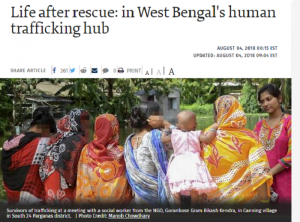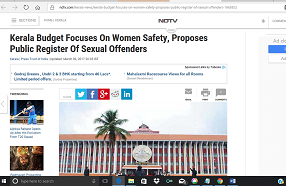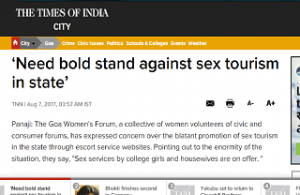Life After Rescue: In West Bengal’s Human Trafficking Hub

Date: Saturday, Aug 4, 2018
Location: Mumbai/West Bengal
Serina (23) was rescued from a brothel in Kalyan, a Mumbai suburb, on December 14, 2016. She was put on a train on February 2, 2017. The journey to her home State, West Bengal, lasted two days. She had to spend some more days at a shelter in Madhyamgram town in North 24 Parganas before being reunited with her family — after one year — in South 24 Parganas district on February 18.
Like many women who had been trafficked into sex work and subsequently rescued, Serina doesn’t like anyone visiting her at her home, where she lives with her three unmarried sisters, all younger than her. She prefers to travel 20 km so that she can meet us at the office of an NGO in the Gokulpara area of Canning subdivision.
The NGO, Goranbose Gram Bikash Kendra (GGBK), works for the welfare of victims of trafficking. Serina, at five feet five inches, is taller than other survivors, but she looks frail. Her medical papers mention her weight as 35 kg. She complains to a GGBK worker that she has been steadily losing weight. A test done shortly after her rescue had diagnosed her as HIV positive.
Serina has to regularly make the nearly 70 km journey from her village to the Alipore Court in Kolkata to find out the status of her petition seeking compensation under the West Bengal Victim Compensation Scheme for trafficking survivors. “I had applied for compensation in July 2017,” she says. “My medical expenses are rising every month. But all I am getting are empty assurances.” Serina has to spend ₹3,000-4,000 every month on tests and medication.
Social boycott
Like Serina, 28-year-old Meher-un Nisa also avoids meeting outsiders at her home. “My return from Pune in early 2017 led to a social boycott of our family. Even buying daily groceries had become a challenge. I did not step out from home for months,” says Meher-un Nisa, whose village is also in Canning. After her rescue, it took her almost a year to muster the courage to visit a police station and lodge a complaint against the man who had trafficked her.
That man was her husband. Having tricked her into marrying him, he took her to Pune on the pretext of getting her a job, and sold her to a brothel. These days she travels regularly to Kolkata to arrange the documents needed to apply for victim compensation.
Following a 2010 directive from the Supreme Court that compensation should be paid to victims of sexual assault, acid attacks and trafficking, many States have set up victim compensation funds. According to the West Bengal Victim Compensation Scheme, 2017, ₹1 lakh is the amount to be paid to victims of human trafficking as compensation.
Serina and Meher-un Nisa are among the thousands of unsuspecting young girls and women who had left their homes after being promised a better future by traffickers posing as well-wishers. Lured by new boyfriends, strangers, and sometimes even family members, these girls are sold to brothels across the country. In recent times, West Bengal has registered an astonishingly high number of trafficking cases.
The latest figures of the National Crime Records Bureau, released in 2017, show that of the 8,132 cases of human trafficking recorded in the country (January to December 2016), 3,579 cases (around 44%) were from West Bengal. Rishi Kant of Shakti Vahini, a Delhi-based NGO, cites a Home Ministry statement in the Lok Sabha, according to which charge sheets had been filed in 1,186 cases of the 3,579 cases reported from West Bengal. “This means that in one-third of the cases, the girls have been rescued and the perpetrators arrested,” he says. From January 2017 to July 2018, Shakti Vahini and the West Bengal police have together rescued 101 girls and women from different parts of north India. Nearly one-third of the girls rescued (34) were from South 24 Parganas district.
Two subdivisions in South 24 Parganas, Diamond Harbour and Canning, have emerged as hubs of trafficking. Over the past few years, they have seen the return of several rescued girls. Life for these young women, who are mostly in their twenties, is tough. They have escaped a nightmarish past but the future is not bright either. Not only do they have to come to terms with the psychological trauma, they also have to continuously battle social stigma. Under these circumstances, securing even a basic livelihood proves a daunting task.
The houses of the survivors and of the girls who have gone missing tell a story in themselves. Located in remote areas of the Canning subdivision, these mostly one-room houses have thatched roofs and almost no furniture. The families have a solitary earning member and multiple dependents, including several children. Most have little or no land. The men travel to Kolkata looking for odd jobs as potters, tailors or masons. A survivor in Uttar Daharani village, whose father works as a mason in Kolkata, said that the cyclone Aila of 2009 changed the nature of the land in the region. The influx of sea water had rendered the area unfit for cultivation.
Another survivor from Budhokhali village, under the Itkhola panchayat in Canning, makes a living making batik prints for saris. When she returned home three years ago after being rescued, her husband refused to take her back. She now lives with her parents.
At Bollartop village, which falls under Basanti police station, a father who works as a mechanic for engine-powered boats speaks of a habeas corpus plea he had filed in the Calcutta High Court in 2017. His daughter, who went missing two years ago, had contacted the family saying that she had been sold to a brothel somewhere and was unable to escape. The father’s hopes rest on the fact that another girl from his village who had also gone missing was rescued in 2017. These families do not have the economic means to wage a legal battle to get their daughters back.
Question of compensation
Of late, the judiciary has begun taking an active interest in the issue. On July 5, 2018, a Division Bench of Justices Ravi Krishan Kapur and Joymalya Bagchi of the Calcutta High Court observed that “the menace of trafficking of women and minors has assumed alarming proportions.” A directive by the Bench that is likely to have a positive impact is that there should be a provision for interim compensation for the survivors, which is to be given to them soon after they record their statements.
Enthused by the Calcutta High Court orders as well as the provisions in the Trafficking of Persons (Prevention, Protection and Rehabilitation) Bill, 2018, recently passed by the Lok Sabha, Kant is hopeful that the rehabilitation of survivors will soon become a legal right. He says that the responsibility for awarding compensation lies with the SLSA.
“Legal aid is not charity, it is the constitutional right of a citizen,” says the pen stand in the office of Ajay Kumar Gupta, the SLSA member secretary, located in the heart of Kolkata. According to Gupta, the number of cases where compensation has been awarded to trafficking survivors has not been made available in the public domain. A Right to Information (RTI) application may be the only route to access this information, he says. “Whenever we have funds, we disburse it among the people,” he says.
Pompi Banerjee, a psychiatrist working with Utthan, a trafficking survivors’ collective that’s active in the North and South 24 Parganas districts, says that she is aware of only three trafficking survivors receiving compensation in the past two years, of which only one has received the money in her account.
South 24 Parganas is one of the most densely populated districts in West Bengal. The last Census put the population density per sq km at 819. Canning and Diamond Harbour are two of the five subdivisions of the districts with high migration and maximum instances of trafficking and missing children.
The missing ones
Responses to several RTI queries by Kolkata-based activist Sabir Ahamed show that South 24 Parganas had the highest number of missing children in the State. In 2012, 2,836 went missing, of which 2,191 were girls. Of these, 1,714 were aged between 14 and 18 years. Ahamed says that while 1,007 of the missing children were traced, the whereabouts of the rest remain unknown.
For Amina Khatun Laskar, who runs Birangana Seva Samity, a small, Canning-based NGO that works for the welfare of trafficking survivors, instances of women and girls going missing is almost a daily phenomenon. “Earlier, it was teenagers and young unmarried girls who were trafficked. Now we are getting cases of even married woman going missing,” says Laskar.
While Laskar is sharing case studies of married women who have gone missing, a burqa-clad woman walks into the room, clutching a passport size photograph and an Aadhaar card. Aliyah Sheikh has not heard from her daughter, Rokeya, since July 14, 2018. Rokeya got married two years ago. “Your daughter was born in 2001,” says Laskar, looking at the Aadhaar card. “Why did you marry her off so young?”
“She was good-looking, so we fixed her marriage with my sister’s son. Her family is a little better off than us,” explains Sheikh. “My husband is paralysed. I earn ₹1,500 a month working as a cook in a local school.” She adds that her son-in-law had told her that her daughter ran away with an autorickshaw driver. Laskar jots down the details but Sheikh has no name for the driver. “She is a minor and the police will have to take the case,” says Laskar, trying to comfort Sheikh.
At the Canning Police Station, on one of the desks lies a charge sheet filed on June 15, 2017 against Asha Das alias Jyotsna Das. Samayun Bashar, the sub-inspector who handles cases of trafficking, takes the chair behind the desk and flips through the charge sheet.
“In 2017, the Canning police station rescued 22 girls. We are yet to count the numbers for 2018 but it could be eight or ten,” says Bashar, recounting the several journeys he had made in 2017 to rescue girls from Gujarat, Pune and Delhi. “Three in Gujarat, three in Pune, one in Delhi,” he counts on his fingers. The most challenging rescue was in Delhi, of a three-year-old who had been sold along with her mother.
Tracking them down
The 25-year-old mother of twin daughters belonged to Sundhipukria area of Canning. She was taken to Delhi, along with one of her daughters, by a woman who had befriended her and promised to get her a job. But the mother ended up in a flat from where a prostitution racket was being run. One afternoon in January 2017, she escaped from the flat but could not take her daughter with her. As he speaks, Bashar is busy making notes on a sheet of paper. “I am travelling to Kolkata tomorrow, the accused (Asha Das) has applied for bail at the Calcutta High Court. I have to brief the public prosecutor about the case so that she does not get bail,” Bashar says.
The rescue of the three-year-old was like looking for a needle in a haystack as there were no telephone numbers to track down, no address and no clues, Bashar says. “For three days we went around Delhi, but the mother could not identify the area from where she had escaped. And when we finally managed to locate the lane, we could not identify the building.” Eventually, with the help of the Delhi Police, they broke into a flat and found three babies of the same age. The babies’ heads had been shaved and measures had been taken to make all of them look alike. Even the mother found it difficult to identify her own baby. “When the mother turned away, the baby started crying and calling out to her in Bengali,” recalls Bashar. “It was as if the child had rescued herself.”
In the adjoining subdivision of Diamond Harbour, Prabir Kumar Bal is the officer-in-charge of the Special Operations Group, Sunderbans Police District. He had rescued six girls from Agra in 2017. Five of them were from South 24 Parganas. Bal had gone looking for a girl from the Mathurapur area of the district, and in the course of his investigation, ended up busting a major trafficking racket involving locals from Diamond Harbour and their handlers in Delhi and Agra.
His eyes light up when asked about the rescue of 18-year-old Sushmita Mondal, an operation that had involved four to five visits to Delhi, Ghaziabad and Agra. “You can make a film on it,” he says, recalling how the police had just one clue to work with — a telephone number Mondal had called several times before she went missing.
“This number kept travelling to Kolkata, Delhi, and back to Diamond Harbour. That was our only clue. Interestingly, the SIM was registered in the name of a woman who worked in Kolkata,” Bal says. The rescue took weeks of planning, help from the Agra Police, and cops posing as customers in order to gain entry into the brothel that held Mondal.
“We went without food for 36 hours. I had assured Bal that if the girl he was looking for was in north India, we would find her,” says Rishi Kant. The activist, who has rescued hundreds of girls, says that little-known police officers travel all around the country to bring these girls back home.
Tathagata Basu, SP of the Sunderbans Police District, says that 13 girls, all residents of the Sunderbans and its adjoining areas, were rescued in 2017, and eight in 2018. He is convinced that trafficking is a well-organised crime, with operators based in West Bengal and other States. He says that traffickers have found a new modus operandi to home in on their targets. They lurk around mobile recharge shops where these girls, mostly schoolgoing, go to get their cell phones recharged, and copy their numbers from the register.
It starts with missed calls, WhatsApp messages, and even the gifting of new mobile phones. A few weeks later, once the girl’s confidence has been won, the trafficker will tell her that he has got a job in Delhi and his parents are likely to get him married. “It is such an elaborate and carefully thought-out plan that the girl is bound to fall into the trap,” Basu says. Raising awareness is the key, he says, as this was the same plot that Farak Ali Gayen had used to trap Mondal.
The West Bengal police has been trying to do just that through the Swayangsiddha initiative, under which police officers regularly visit schools and colleges and urge girls not to respond to missed calls from unknown numbers. Sometimes survivors like Serina and Meher-un-Nisa also visit these awareness camps and speak to the girls.
A different journey
Meher-un-Nisa has come a long way since her return from Pune. Last month, she went on another journey, this time of a different kind. Along with another survivor, she flew to Delhi, on July 18, to participate in a consultation on the Trafficking of Persons (Prevention, Protection and Rehabilitation) Bill. The next day, in the presence of three MPs — Shatrughan Sinha, Manoj Tiwari and Kothapalli Geetha — she picked up the microphone and explained how women like her fall into the trap of traffickers. “First they win your trust by giving money or provisions for your family,” she told the gathering. “They target poor girls who belong to families that can barely make their ends meet.”
Later in the evening, she told one of the participants of the seminar that the man who had trafficked her still remains at large. An inter-State agency to investigate such cases, as proposed in the Bill, could apprehend those operating in different States, she said. Little did she know that her wish was to come true almost a week later. On July 26, the Bill was passed in the Lok Sabha, amidst concerns by the Opposition. For Meher-un-Nisa, Serina and others like them, the Bill, yet to be passed by the Rajya Sabha, offers a ray of hope.
Names have been changed to protect identity.
Read The Hindu (Source) article here.
“It’s Saturday evening at the National Human Trafficking Hotline, and we’ve had non-stop calls since mid-afternoon. I know there are Read more
“It’s Saturday evening at the National Human Trafficking Hotline, and we’ve had non-stop calls since mid-afternoon. I know there are Read more



